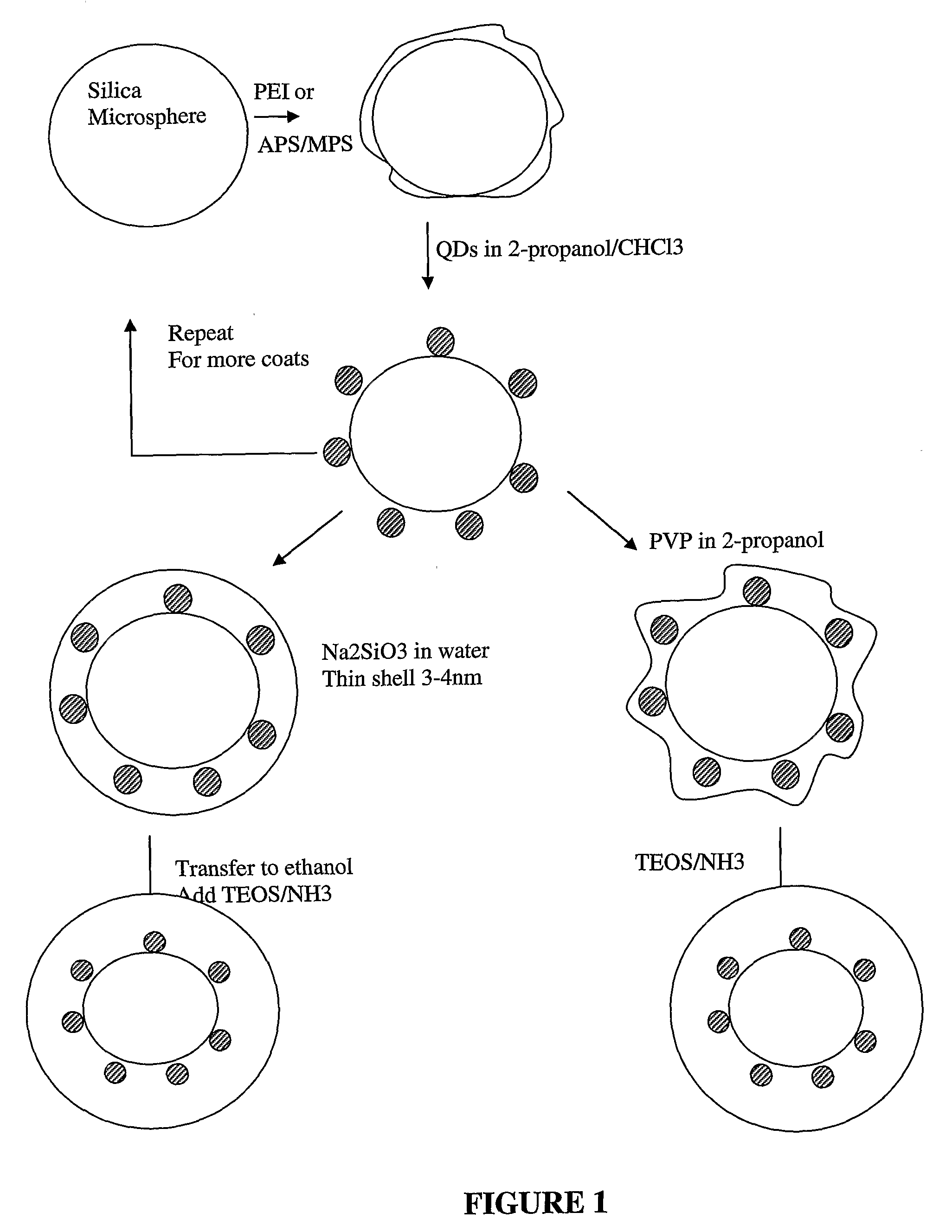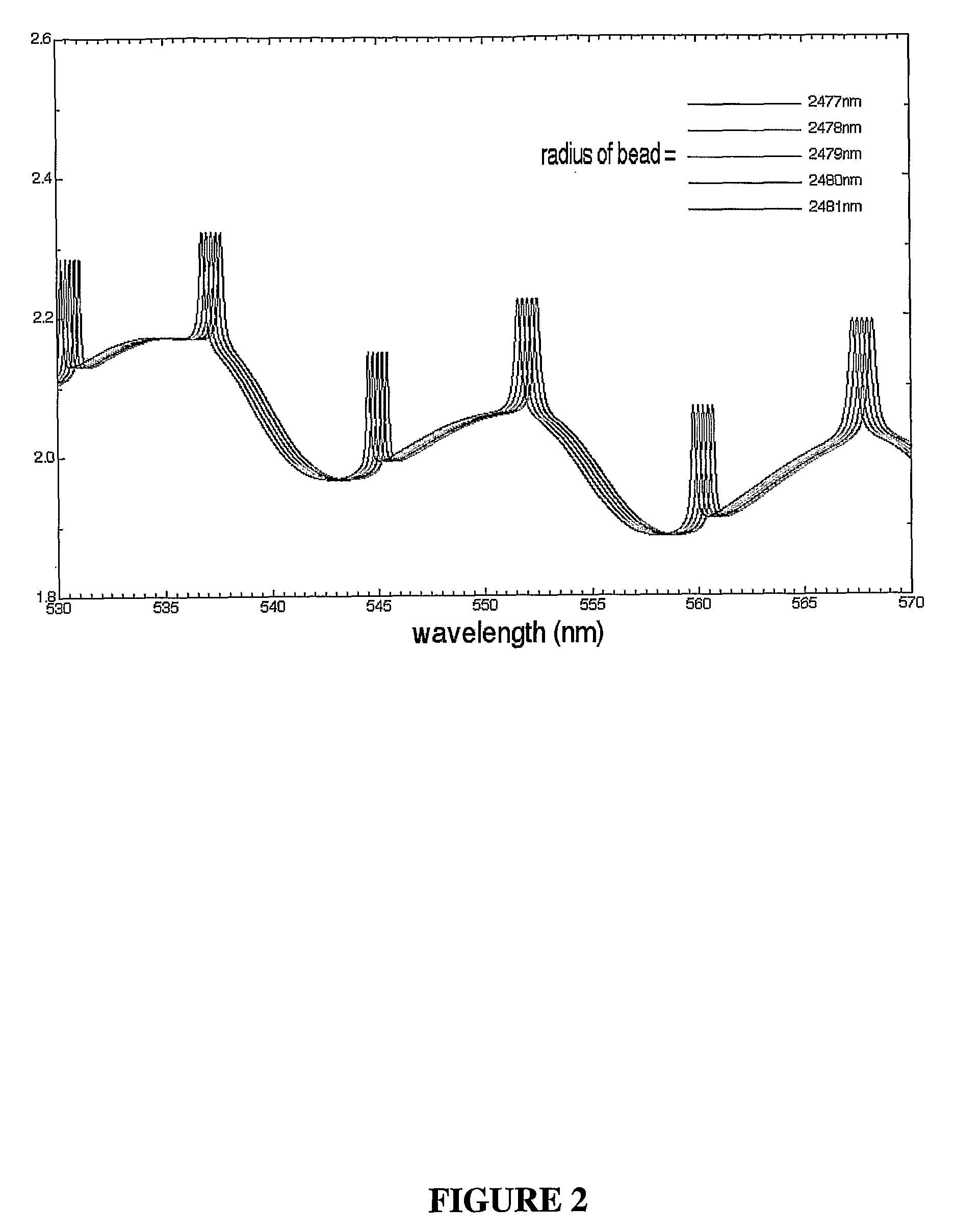Biosensor Using Whispering Gallery Modes in Microspheres
a microsphere and biosensor technology, applied in the field of analyte detection, can solve the problems of limited ability for multiplexing measurements, specific and expensive instruments for spr, etc., and achieve the effect of sensitive detection
- Summary
- Abstract
- Description
- Claims
- Application Information
AI Technical Summary
Benefits of technology
Problems solved by technology
Method used
Image
Examples
example 1
Production and Labeling of Quantum Dot Labeled Microspheroidal Particles
[0153]Typically, microspheroidal particles may be prepared by overlaying commercial beads of any desired composition or size with quantum dots. For more robust materials, they should be overcoated with another silica layer to minimize interactions with the medium or adsorbates.
[0154]Without limiting the many possibilities, described herein is a typical process used to prepare microspheroidal particles using glass / silica beads.
[0155]0.1 g of five micron diameter commercial silica beads were placed in 20 ml 2-propanol and 20 microlitres of either mercaptopropylsilane (MPS) or aminopropylsilane (APS) was added. The solution was refluxed at 80° C. to allow chemisorption of the MPS or APS, which led to the creation of mercaptan or amino groups on the bead surface. Excess MPS or APS was removed by centrifugation.
[0156]Instead of a silane functionalized bead, the beads can also be activated by adsorbing a cationic poly...
example 2
DNA Detection
[0164]Q-Sand beads were conjugated to DNA, forming a complex with a Q-Sand bead and immobilized 48-mer DNA. The fifth base position of the 48-mer was a thymidine base with an incorporated amine. This amine was used to label the DNA with a BODIPY·630 / 650 NHS ester using a standard condensation reaction. The WGM profile for the Q-Sand bead conjugated to the 48-mer DNA is shown in FIG. 5, panel a.
[0165]Panel b of FIG. 5 shows the WGM profile of the Q-Sand bead of panel a conjugated to a α-Transprobe DNA which hybridizes to bases 6-24 of the DNA conjugated to the Q-Sand bead. The resulting WGM profile, as seen in panel b of FIG. 5, was a shift of approximately 2.4 nm for all peaks. In addition, the Q-factor (the measure of the quality of the microresonator) reduction was approximately 5×.
[0166]Finally, the Q-Sand beads shown in FIG. 5, panel a, were hybridized to a PCR product containing a complementary region to DNA bases 25-48 of the DNA 48-mer. The PCR product was genera...
example 3
Surface Functionalization of Silica Microspheroidal Particles
[0167]Surface functionalization of silica microspheroidal particles can be done in the same way used for the initial silica microspheroidal particles by refluxing the QD-silica microspheroidal particles in 2-propanol containing MPS or APS or other silane to activate the surface and add functional groups which react with the target bioadsorbate.
Preparation of Conjugates
[0168]5 micron microspheroidal particles labeled with orange QDs emitting at 560 nm and overcoated with 10 nm silica were treated with MPS, centrifuged and washed. The microspheres were allowed to react in water with the conjugate, such as a nucleic acid, polypeptide, antibody, carbohydrate or the like for about 1 hour. They were then centrifuged and washed to yield Bioactive QD Microspheres (BQDM).
Binding Assays:
[0169]Several BQDM are placed on a microscope slide under a confocal microscope. A drop of reference solution is placed on the microspheres and the ...
PUM
| Property | Measurement | Unit |
|---|---|---|
| diameter | aaaaa | aaaaa |
| wavelength change | aaaaa | aaaaa |
| wavelength change | aaaaa | aaaaa |
Abstract
Description
Claims
Application Information
 Login to View More
Login to View More - R&D
- Intellectual Property
- Life Sciences
- Materials
- Tech Scout
- Unparalleled Data Quality
- Higher Quality Content
- 60% Fewer Hallucinations
Browse by: Latest US Patents, China's latest patents, Technical Efficacy Thesaurus, Application Domain, Technology Topic, Popular Technical Reports.
© 2025 PatSnap. All rights reserved.Legal|Privacy policy|Modern Slavery Act Transparency Statement|Sitemap|About US| Contact US: help@patsnap.com



